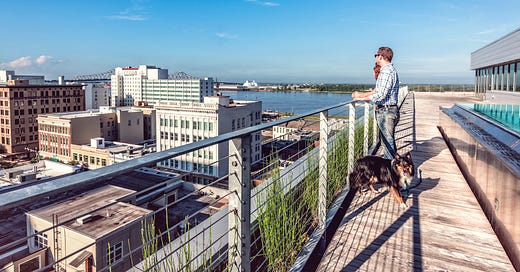A Decade of Downtown BR Development, at a Glance
As Baton Rouge’s Downtown Development District picks its new Executive Director, now is a good time to take stock of the neighborhood’s growth
In most metro areas in the country, the downtown area of the largest city tends to be an important part of the community – the density allows it to have a greater economic impact per square foot, the variety of businesses and services draw residents from diverse populations, and downtowns regularly host events that add to the vibrancy and identity of the community.[1] In addition, they often provide walkability, which young professionals – a worker subgroup in high-demand – prefer for both residence and recreation. Since downtown areas are crucial to the desirability and culture of a region, this time of transition for the Downtown Development District (DDD) is a good chance to look at Baton Rouge’s downtown.
The population within DDD’s footprint grew over 25% between the 2010 and 2020 Censuses, which is significantly greater than East Baton Rouge as a whole, which was up 4%.[2] In fact, the downtown population growth was greater than Ascension Parish’s 18% – this is notable, as Ascension is one of the fastest growing parts of the state. This growth is important, as larger populations in downtown areas make it possible for more and varied businesses to locate there.
Presently, there is quite a bit of commercial activity in the neighborhood. There are more than 1,700 businesses with nearly 29,000 employees in DDD’s footprint.[3] The two largest sectors are government, thanks to the presence of the state capital, and professional services, which, together, account for almost 19,000 of the jobs downtown. These jobs, the more than 2,000 housing units downtown, as well as travel and tourism support a strong accommodation & food services sector, which accounts for 103 businesses and almost 1,800 downtown jobs. However, the retail sector has a relatively sparse presence within the DDD boundaries. Non-food related retail accounts for fewer than 60 of the 1,700 downtown businesses and fewer than 350 employees – about 1% of everyone that works downtown.
As the Capital Region continues to try and retain top young talent while also attracting it from outside the region, an emphasis on continuing to grow the size and vibrancy of downtown will be critical to that mission. Understanding the growth that’s happened so far, as well as the assets and liabilities downtown currently has, will be key in ensuring smart growth going forward.
[1] The Value of U.S. Downtowns and City Centers (2017)
[2] U.S. Census; BRAC analysis
[3] American Community Survey, 2019




